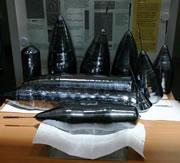 Two-million-euro dumbell: in the foreground, a lump of pure silicon.Josef Zens, Institute for Crystal Growth
Two-million-euro dumbell: in the foreground, a lump of pure silicon.Josef Zens, Institute for Crystal GrowthResearchers are a step closer to redefining the kilogram, thanks to the creation of the purest chunk of crystalline silicon-28 yet made.
Today's standard kilogram is defined by a chunk of platinum-iridium alloy kept in a vault near Paris, France. But researchers are concerned that atoms lost and gained from the metal have altered its weight by perhaps 0.1 milligrams over a century or so. This would alter the standard against which precise instruments are calibrated.
One way to improve upon this system is to create a crystal of such perfection that its number and type of atoms can be precisely determined. This, combined with a knowledge of the weight of each atom, would allow a more precise definition of weight.
Researchers have attempted this with a lump of natural silicon. But determining the proportion of different isotopes of silicon in that chunk, using mass spectrometry, introduced error in the measurements.
"The mass spec is the weakest, least precise measurement in this system," says Helge Riemann of the Institute of Crystal Growth in Berlin, Germany. With this object, again a kilogram could only be determined to within about 0.1 milligrams.
The new barbell-shaped crystal, which weighs 5 kilograms and was completed on 23 May by Riemann's team, should help to beat this record because it is nearly isotopically pure. It was made from Russian source material, whose silicon was 99.994% pure silicon-28.
The researchers spent six months eliminating contaminating elements by repeatedly melting the silicon in an apparatus that does not touch the material. The resulting crystal is thought to contain one foreign atom to every 10 million atoms of silicon.
"They're certainly making it as pure as they can," says Ian Robinson, a physicist working on an alternative definition for the kilogram at the National Physical Laboratory in Teddington, UK.
Defining by number
The object — worth about 2 million euros — will now be divided and polished into two 1-kilogram spheres in the next year, with the material from the middle of the barbell saved for testing purposes. But further years of measurement are needed before these objects' weights can be determined precisely — including isotopic analysis of the other 0.006% silicon in the crystal, X-ray measurements of the crystal packing, and precise measures of sphere volume.
"It will take two to three years yet," says Reimann. If all goes well, the process should be able to measure a kilogram with an error of a few hundredths of a milligram.
Success will mean that defining the kilogram by a number of atoms is a (sort of) practical thing to do. Although the crystal will also change over time, there will be a written definition that will remain constant.
ADVERTISEMENT
Other teams continue to pursue other, complimentary avenues, including using a 'watt balance' to measure electromagnetic and gravitational forces around a weight. Comparing the results from each approach will be important. But none has yet been perfected.
"At the moment, the best error quoted is 3.6 x 10-8," says Robinson — that's 0.036 milligrams per kilogram, thanks to a group at the US National Institute of Standards and Technology. "We're all moving towards 2 x 10-8. We're all on the way there."
Visit our crystalcookedtoperf.html">newsblog to read and post comments about this story.
